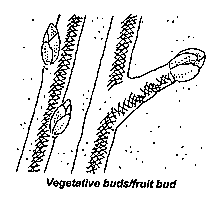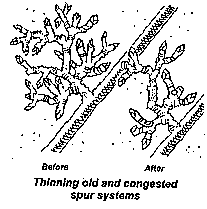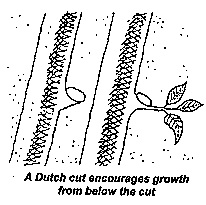

EAP Publications | Virtual Library | Magazine Rack | Search | What's new
Join the Ecological Solutions RoundtableIdeas on pruning apples and pears have changed dramatically in the last twenty years but many gardening books have not kept up-to-date. If you are already confused, this may help.
The pruning of top fruit carries a mystique that leaves many gardeners either too worried to start or too confused by the diagrams to achieve anything. I have yet to kind a tree that matches the pictures that we gardening writers use as illustrations. Cultivating such a mystique does wonders for personal kudos but does nothing for the fruit trees which will become unhealthy and unproductive if not cared for. Pruning is actually quite simple, once the essential principles and a bit of basic plant knowledge are grasped. It is important to understand what you are trying to achieve, how the trees grow and what pruning will do for them.
Sunlight is the key element to healthy, bountiful fruit. Since sunlight is not a guaranteed commodity in our climate, it pays to make the best use of it. Leaves need to be able to gather sunlight to photosynthesise and produce the food source necessary to build trees and create fruit. Leaves in deep shade in the center of a crowded tree cannot photosynthesise efficiently; too little leaf will leave the tree short of stored resources for the following year. Pruning aims to get sunlight in and achieve a balance reconciling fruiting with growth. Pruning must also, therefore, include fruit thinning, since a heavy crop, as well as breaking branches, will take all the energy from a tree and reduce the likelihood of any fruit in the next year.
So, what are we trying to achieve? There are a number of clear aims:
Reduce shading Formal shapes such as cordon, espalier and fan create little shade within the tree canopy but bushes can become densely crowded; they need to be open and airy with no branches in the center.
Control vigor Some varieties are much more exuberant in growth than others. Timing of pruning can help to control growth as can fruiting, which channels resources away from production of shoots and roots.
The first growth phase in the spring after bud-burst and flowering is strong production of new wood. A flush of new shoots generally follows winter pruning-- the harder the pruning, the stronger the growth. By late May, however, trees begin to channel more energy into fruit production and less into wood growth. Pruning in summer does not tend to result in vigorous regrowth. For this reason, tightly controlled shapes such as cordons are summer pruned.
Maintain health. Removal of dead and diseased tissue prevents spread of diseases which might kill the whole tree It pays to be vigilant. Powdery mildew, for example, can be kept effectively in check by opportune snipping; thinning of fruit gives an opportunity to remove sawfly-ridden fruitless, as well as being good for the general health of the tree--too much fruit strains the whole organism.
Improve or adjust cropping It is most important to be able to distinguish between fruit buds and vegetative buds (see overleaf). The best fruit is generally produced on wood less than five years old. It makes sense, then, to remove some of the older fruiting laterals every year to encourage newer growth. It does no harm to cut out some fruit buds if the tree is well furnished. If every flower fumed into a fruit, the poor tree would be drooping with exhaustion before long
Retain shape. The shape of a tree, whether it be pyramid, spindle, fan or bush, is designed not only for best cropping but also to make it easy to pick. Horizontal branches not only crop better but are easier to reach. The best shapes are either open-centered (bush) or pyramidal (spindle, dwarf pyramid), allowing plenty of light penetration and easy access for harvesting.

So much for the theory, now for the practice. In the interests of simplicity, I will use a chronological guide and concentrate on trees that have already been formed and are, at least, semi-mature.
Cordons, espaliers and pyramids: These are not normally pruned at this time of year However, winter is the best time for thinning or cutting out old and congested spur systems The central leader of pyramids should be reduced to I or 2 cm, unless it is over 45 cm long If it is, prune it back in May.

Bushes: Step 1--Remove all dead, diseased or damaged branches to a suitable healthy bud or sideshoot. Step 2-- Remove all strong upright growth either completely or to leave a stub if there are not many spurs along the branch Remove all branches growing into the center of the tree. Step 3--Prune back the leading shoots of the main framework branches either by about half to an outward-facing bud or, if the branch is rather upright or excessively long, to a flatter-angled branch nearer the center. Step 4--Now for the detail. 'Either cut it out altogether or leave it alone' would be a reasonable maxim to follow. Work along the framework branches one at a time, keeping to the following rules:
a) shoots growing directly downwards from the branch--remove;
b) strong upright growth--remove-- to leave a stub about 2-3 cm long at a bud;
c) branching up lateral shoots up to four years old (check the annual growth colIars)--leave alone (except pears, see below)
d) older lateral systems--remove with a sloping Dutch cut (see illustration);
e)some four year old laterals can become crowded. If so, cut some of the shoots back to the last fruit bud.
Pears are pruned slightly differently: allow shoots to grow for two years and then prune back to leave four to six fruit buds. All subsequent side-growth is removed in winter until the whole lateral is cut out as in d).

Bushes: Remove strong upright growth but be cautious. Removing too much lea] at this time may weaken the tree.
Fan, cordon, espalier, dwarf pyramid Step 1--Prune back any laterals over
20 cm long arising from the framework to three leaves. Step 2--Any other side shoots from these or older laterals are cut back to one leaf.
Note: It is important not to prune shoots which arc not yet woody at the base.
Return to restricted form trees and cut out any regrowth and prune those shoots that were too short in August. Any shoots still less than 20 cm long can be left intact unless badly placed.
There--that wasn't too mystical, was it?
Vegetative bud: Bud from which a leaf or shoot will develop (see illustration).
Fruit bud. Bud from which a flower truss will develop (see illustration).
Basal cluster. Ring of closely spaced leaves at the base of current season's growth.
Lateral. A side shoot from a branch.
Framework branch (or scaffold). A permanent branch from which laterals grow.
Spur. A short branching shoot containing one or more fruit buds. A spur system is an older complex of such branchlets.
Dutch cut. Sloping cut at the base of a branch or lateral (see diagram) designed to encourage growth from below the cut.
Leader. The terminal growth of a central (spindle/pyramid) or framework branch.
Jack Woodward. Pruning Hardy Fruits
Info Request | Services | Become EAP Member | Site Map
Give us your comments about the EAP site
Ecological Agriculture Projects, McGill University (Macdonald
Campus)
Ste-Anne-de-Bellevue, QC, H9X 3V9 Canada
Telephone:
(514)-398-7771
Fax:
(514)-398-7621
Email: eapinfo@macdonald.mcgill.ca
To report problems or otherwise comment on the structure of this site, send mail to the Webmaster